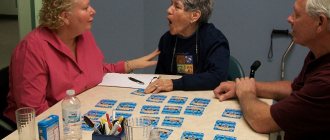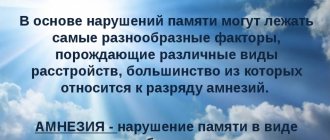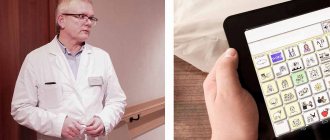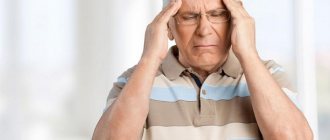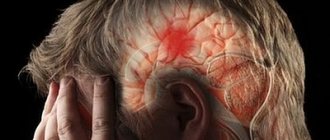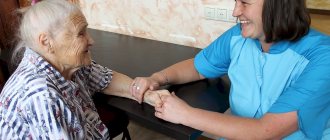10 minutes
171 views
A stroke is an acute disorder of cerebral circulation, leading to the destruction of brain tissue. Every year in Russia there are 450,000 cases of stroke - one every 1.5 minutes.
The causes of ischemic stroke can be atherosclerosis of cerebral vessels, coronary heart disease with cardiac arrhythmias, heart defects, osteochondrosis of the cervical spine, and arterial hypertension. With these diseases, obstruction or blockage of brain vessels develops, the blood supply to the brain is disrupted, which leads to bleeding of the brain - ischemia. If blood circulation in the ischemic area is not quickly restored, the brain tissue in it dies. The dead tissue then gradually dissolves to form cysts (holes) in the medulla.
The consequences of ischemic stroke are determined 90% by its severity and only 10% depend on treatment. Therefore, preventing stroke is many times more effective than treatment; Hippocrates said: “It is easier to prevent a disease than to treat it.”
Stroke prevention: simple rules for preventing stroke
What should you expect when you return home?
When you are discharged from the rehabilitation center, you will be given a discharge summary. It will cover all the necessary guidelines for caring for you at home, as well as the necessary equipment and supplies you may need. Returning home can be initially scary. You may not fully recover and will need to continue rehabilitation on an outpatient basis. You may also have many questions about how you can continue living a full life after a stroke.
Restoration of motor functions
We recommend
“Private boarding house for the elderly: selection criteria and registration procedure” More details
Wherever rehabilitation after a stroke takes place in an elderly person - at home or in a boarding house - the priority should be the restoration of all lost functions. Sometimes it happens that full regeneration may not occur. For this reason, the recovery period of motor functions can be divided into two groups:
- Complete – complete rehabilitation of all lost abilities of the body.
- Compensation for lost abilities if full recovery is impossible. A sick elderly person should receive at least the necessary minimum of household skills.
Even if complete rehabilitation does not help restore lost skills, you need to follow a full list of recommendations, exercises and undergo comprehensive treatment. Under no circumstances should you refuse a full recovery.
The rehabilitation process during this period should consist of several stages. In the first days and weeks, it will be enough to perform simple exercises without excessive physical activity. Later, the elderly patient will try to complete assigned tasks independently. The caregiver should assist the patient only in difficult cases.
After this stage, rehabilitation of motor functions begins. The first is imitation of steps, without getting out of bed. Next, you need to help the elderly person get up and just stand in one place for a while. You can use improvised objects as support: chairs, headboards. After an attack, a person must begin to walk again on his own, with a little help from a caregiver.
The most difficult task is to restore the motor abilities of the hands. This is due to the fact that many damaged brain cells are responsible for this function. But be that as it may, this temporarily lost ability can still be restored if the problem is addressed as soon as possible. It is important to realize that the process of rehabilitation after a stroke of an elderly person is a long and labor-intensive task, but effective.
You can immobilize the healthy arm for several hours so that the elderly patient tries to serve himself only with the affected arm. For example, he held a spoon, typed on the computer, washed his face.
Fatigue
Fatigue is one of the most common symptoms of stroke. This symptom affects most people who have had a stroke, regardless of its severity, and is usually most noticeable when they return home from the hospital.
This type of fatigue is different from the usual and usual fatigue for us, and it does not depend on your activity or activity. Each of us sometimes feels tired, but this feeling often goes away after rest. However, after a stroke, the fatigue you feel may make you feel like you don't have the energy to do anything. Often you may feel that the feeling of fatigue comes completely unexpectedly and at this moment the only thing you can do is rest until this feeling passes.
Sometimes it takes months or even years for this symptom to go away. Many people after a stroke say they have good days and bad days - days when they feel they can do more things and days when they need to rest more because they feel tired. During the recovery process, good days tend to increase and bad days decrease. Often this fatigue is invisible to other people, so it can be difficult for them to understand what you are feeling. Despite this, you can help yourself in various ways. The key to success is to realize that it is not your fault and it is not your fault. You need to accept the fact that it takes a long time to overcome this symptom of fatigue.
Levels of recovery after stroke
After hemorrhagic and ischemic strokes, there are three levels of recovery:
- the first is the highest. We are talking about the complete restoration of lost functions to their original state. This option is possible in the absence of complete death of nerve cells in a region of the brain;
- the second level is compensation. The early stage of recovery, usually in the first six months after a stroke. Lost functions are compensated by the involvement of new structures and functional restructuring.
- The third level involves readaptation, that is, adaptation to the emerging defect. The patient’s relatives and friends play a significant role in this process. They are the ones who help the patient learn to live with the emerging defect.
Specialists at the Yusupov Hospital, if necessary, work with the patient’s relatives, teaching them the specifics of care, as well as providing them with psychological support.
Daily routine
A daily home routine can be helpful. Your day will be less monotonous and this will allow you to learn to listen to yourself and determine when you feel active and do some housework accordingly. The daily routine is based on your needs and the needs of your loved ones. Think about what chores you need to do every day, what you can do on your own, what you need help with, and what you will need to learn to do again. Think about how much time you will need to complete all this work. If you feel yourself getting tired, try to perform the most difficult and tiring tasks that require more energy during the day or week when you feel more energized, making sure to take time to rest. It is very important to be as active as possible. Try to continue your hobbies, social activities and other activities as much as possible. And if you can, try to breathe fresh air every day!
Stay active and keep in touch with friends and acquaintances
Many people feel weak, have difficulty speaking, or have any other problems after a stroke. This leads to them losing interest in the outside world and not wanting to communicate with friends and acquaintances. An important step in rehabilitation after a stroke is socialization. You may find it difficult to go to places you used to go to before your stroke because of your mobility problems, or you may be worried that you will not be able to cope with your problems outside the home. You may find it easier to stay home, but this can lead to isolation, loneliness and low mood. There is always a solution to problems, you can take the help of others or use a stroller to move around. Try to keep in touch with your close friends, invite them to visit or travel with them. It will help if your friends know your capabilities, what you can and cannot do. Meeting new people may be intimidating at first, but it is likely that meeting new people can be especially beneficial for you. Often people make new friends with people who have also had a stroke, and this helps them share their experiences. A positive mood, an active life and maintaining relationships with friends and acquaintances are the key to your recovery.
To minimize the consequences of an ischemic stroke, there is only the first 4.5 hours
— Alexander, what happens in the body during a stroke and why are its consequences so serious?
— A stroke is an acute disorder of cerebral circulation when the blood supply to any part of the brain is cut off. The blood supply is disrupted - and damage or death of brain cells occurs, and this leads to disruption of any body function - speech, movement of the limbs, mental abilities, attention, memory, etc.
— Why is cerebral circulation disrupted?
- A stroke occurs either due to a blockage of a blood vessel that supplies the brain (ischemic stroke) or when a blood vessel in the brain ruptures (hemorrhagic stroke).
Blockage of the vessel can be caused by the formation of atherosclerotic plaques (fatty deposits) or a blood clot that enters the bloodstream and causes a blockage of the artery.
Vessel rupture during a hemorrhagic stroke usually occurs in the softened artery wall: blood leaks out and accumulates, which leads to compression of brain tissue and cell damage. In both cases, as a result of a lack of oxygen, some brain cells at the site of the stroke die, and some are damaged.
Within minutes, the person loses the ability to reason, speak, or move their arms or legs.
about possible contraindications, consult a specialist
- What symptoms indicate a stroke?
— There is a simple test that will help relatives recognize a stroke. You need to ask him to do only three actions: smile, raise both hands and say his name. If the corner of the mouth droops when smiling, if a person cannot raise his arms because one of them is weak, and if he pronounces his name unintelligibly, call an ambulance immediately.
Remember: in case of an ischemic stroke, to effectively remove a blockage of a vessel (thrombus), there is only 4.5 hours until the cells of the damaged area are completely dead.
Signs of a stroke may also include:
- sudden numbness of the face, arms, legs, weakness in the limbs,
- sudden loss of consciousness, loss of ability to speak, difficulty speaking, loss of ability to understand the meaning of someone else’s words,
- sudden loss of vision in one or both eyes,
- sudden disturbance in gait, dizziness, loss of balance,
- sudden severe headache of unknown cause,
- sudden nausea, pain in the face or limbs, general weakness (more often in women).
— Why is it so important to seek medical help in the first hours after a stroke?
— A stroke is an emergency. Medical care is most effective only in the first 3-5 hours: this is the so-called therapeutic window, during which treatment can restore damaged brain cells and minimize the consequences of a stroke. If you do not seek help in time, the cells will die irrevocably, and further treatment will be aimed only at adapting to life, taking into account the existing disorders.
about possible contraindications, consult a specialist
— How is a microstroke different from a regular stroke? Is it just as dangerous and also requires treatment?
— A microstroke, or transient ischemic attack (TIA), is a temporary disruption of the blood supply to part of the brain, that is, a harbinger of a stroke. During a TIA, a person may experience some or all of the symptoms described above.
The peculiarity of a micro-stroke is that these symptoms are usually mild and pass quickly - the next morning a person can feel great.
But take them seriously - be sure to call an ambulance! Your health and life depend on it.
Emotional state after a stroke
You will need time to understand what is happening to you, and understanding this is an important step in your recovery. It is important to remember that recovery and recovery time varies from patient to patient.
Try to share your feelings and sensations with people you trust. People often experience a variety of feelings after a stroke, such as:
- Fears and concerns are a natural shock, mistrust and feelings of loss can affect you and your family. You may be worried about partial memory loss or may be afraid of having another stroke.
- Anger and frustration – You may be angry about something that happened to you or you may be frustrated that you can't do the things you used to do, especially if you have difficulty speaking. Sometimes you may be irritated by other people around you, you may have changes in mood, this is something that can affect you and your family.
- Depression and Anxiety – You will probably experience feelings of anxiety and worry and this is quite normal. Depression is a natural process that occurs after a stroke, so if you are often depressed, you may want to talk to your doctor and start taking antidepressants.
- Tension in relationships – irritability and increased emotional state can lead to tension in relationships with people who are close to you. You may find yourself directing your anger, anger, and frustration towards those close to you. Remember that your family and your friends are trying to understand you and how you feel.
- Loss of self-confidence – Feelings of self-doubt and low self-esteem are common after a stroke, but you should focus on becoming as independent as possible and should take as many opportunities as possible to improve your self-esteem. Making the right decisions about how to care for you, learning new skills, and setting realistic, achievable goals can help you do this.
- Lack of incentive – Recovery from a stroke usually occurs gradually with small but important goals and achievements. If you feel tired and in a low mood, this can affect your motivation to heal and recover. You can set small and achievable goals, and this may feel strange at first, but it will help you stay in a good mood and help you stay motivated and eager to recover. It is vital to stay in a good mood. Remember that it is quite normal if everything works out for you one day, but not the next. There are limits to what you can achieve and do!
REHABILITATION AFTER STROKE
About 400 thousand strokes occur annually in Russia, and 30-35% of patients who have had a stroke die in the acute period (that is, in the first 3-4 weeks). Survivors experience certain consequences of the stroke (almost 80%), and most often these are motor and speech disorders (35%). In this case, many patients experience spontaneous (spontaneous) partial or complete restoration of impaired functions. There are various rehabilitation measures that can speed up this spontaneous recovery.
Rehabilitation is understood as a set of measures (medical, psychological, pedagogical, social, legal) aimed at restoring functions lost as a result of illness or injury, at restoring the social status of an individual, that is, at his social and psychological readaptation.
Basic principles of rehabilitation:
- Early start of rehabilitation measures, which are carried out from the first days of a stroke (if the general condition of the patient allows) and help speed up the pace and make the restoration of impaired functions more complete, prevent the development of secondary complications (thrombophlebitis, contractures, bedsores, congestive pneumonia, etc.).
- Duration and systematicity of rehabilitation therapy are achieved only through properly organized rehabilitation, which should begin in the angioneurological department, where the patient is delivered by ambulance, then continue in the rehabilitation department of the hospital and/or in the rehabilitation center and subsequently be carried out either on the basis of the rehabilitation department (or office) clinic, or in a rehabilitation sanatorium.
- The complexity and adequacy of rehabilitation measures can only be ensured by highly qualified specialists: neurologists-rehabilitators, exercise therapy methodologists, speech therapists-aphasiologists, physiotherapists, psychotherapists, occupational therapists.
- Patients and their families should take an active part in the rehabilitation process (in particular, in doing “homework” in the afternoon and on weekends).
Recovery factors
The very possibility of recovery is based on such a general biological law as the reorganization of functions, that is, on the ability to rearrange and participate in the restoration of the impaired function of those neuronal ensembles and connections that were not previously involved in its implementation. Factors such as the disappearance of edema around the affected area (hemorrhage or infarction), improvement of blood circulation in this area, and disinhibition of functionally inactive neurons are of certain importance in restoring functions after a stroke.
The prognosis for recovery is largely determined by the size and location of the lesion. The localization of the lesion in the posterior thigh of the internal capsule, where the motor pathways converge into one bundle, is prognostically unfavorable for the restoration of movements. For speech restoration, the localization of the focus in both speech zones is unfavorable: in the center of motor (own) speech (in Broca's area - the posterior part of the left inferior frontal gyrus) and in the center of sensory (understanding the speech of others) speech (in Wernicke's area - the posterior part of the left superior temporal convolutions). Unfavorable factors are various emotional-volitional (lack of spontaneity, decreased mental and motor activity, severe depression) and cognitive (decreased intelligence, memory, attention) disorders.
Contraindications for active motor rehabilitation include heart failure, angina at rest and exertion, acute inflammatory diseases, and chronic renal failure. Both speech and motor rehabilitation are impossible if patients have dementia and mental disorders.
Motor rehabilitation
The main method of rehabilitation of post-stroke patients with movement disorders (paresis, static and coordination disorders) is physical therapy (kinesitherapy), the objectives of which include restoration (full or partial):
- range of motion, strength and dexterity in paretic limbs;
- balance functions in ataxia;
- self-care skills.
Kinesiotherapy classes should be conducted by an experienced methodologist, who, after the main lesson with the patient, gives him and his family homework.
In special rehabilitation centers, in addition to kinesitherapy, patients are prescribed electrical stimulation of the neuromuscular system of paretic limbs and classes are conducted using the biofeedback method. This method is based on the constant monitoring of various physiological parameters (for example, the amount of muscle tension, balance, etc.) and their transmission to the patient and the doctor using various electronic devices in the form of visual, audio or other feedback signals. For the patient, these signals are a source of additional information about the results of movements. Exercises using biofeedback (usually specially designed computer games are used) not only help restore impaired functions (dexterity, strength, balance, etc.), but also increase the patient’s activity, improve attention function, and reaction speed.
Physical therapy classes begin in the first days after a stroke, as soon as the general condition of the patient and his state of consciousness allow. First, these are passive gymnastics (movements in all joints of the paretic limbs are performed not by the patient, but by the methodologist or relatives or nurse instructed by him), light exercises performed without tension in those joints of the paretic limbs where they are preserved, and in healthy limbs, breathing exercises. Exercises are carried out under the control of pulse and blood pressure with mandatory pauses for rest. In the future, the exercises become more complicated, the patient begins to sit down, and then is taught to sit down independently and get out of bed. The timing of activation of patients is determined by many factors: the severity of the stroke (the size of the hemorrhage or infarction, the amount of edema, the dislocation of brain structures), the general condition of the patient, the state of hemodynamics, the severity of paresis. In some patients, activation (the patient begins to stand up) begins on the 3-5th day after the stroke, in other cases - after 2-3 weeks.
An important stage of rehabilitation is learning to stand and walk. In patients with severe leg paresis, this stage is preceded by an imitation of walking while lying in bed or sitting in a chair. The patient learns to stand first with the support of a methodologist, then independently, holding on to the bedside frame or headboard. In this case, the patient tries to evenly distribute body weight between the paretic and healthy legs. Subsequently, the patient learns to walk. First, this is walking in place, then walking around the ward using a bedside frame, then walking independently using a four- or three-legged cane. With good stability, the patient is immediately taught to walk using a stick.
The patient can begin walking independently without support from a stick only with good balance and moderate or mild leg paresis. The distance and volume of movement gradually increases: walking around the ward (or apartment), then walking along the hospital corridor, up the stairs, going outside and, finally, using transport.
Some patients with mild impairments “skip” many of the above-mentioned stages and immediately begin to walk independently over relatively long distances, while others “get stuck” at certain stages. Many patients have a tendency for the paretic foot to sag, which makes it difficult to restore walking. Such patients are recommended to wear boots with high rigid fastening. To prevent stretching of the shoulder joint bursa in patients with severe paresis of the arm while walking, it is recommended to fix the arm with a scarf.
The restoration of self-care and other everyday skills also occurs in stages. Initially, this is training in the simplest self-service skills: eating independently; personal hygiene skills, such as washing, shaving, and so on (we are talking about seriously ill patients who have lost these skills); then learning to dress independently (which is quite difficult with a paralyzed arm), use the toilet and bathroom. Various technical devices help patients with hemiparesis and ataxia to use the toilet and bath independently - handrails near the toilet, brackets in the walls of the bathroom, wooden chairs in the bathtub. These devices are easy to make both in the hospital and at home.
With good restoration of self-care and walking skills, patients should be involved in household work; Young patients with mild post-stroke disorders should be prepared for returning to work.
Combating complications of the post-stroke period
One of the serious complications of the post-stroke period is an increase in tone (spasticity) in the muscles of paretic limbs. In some cases, it can be observed already in the first days after a stroke, in others - after 1-3 months. Increasing spasticity can lead to the development of contractures.
Activities aimed at reducing spasticity and preventing the development of contractures include:
- positional treatment: laying the limbs using special splints for 2 hours (1-2 times a day) so that the muscles in which an increase in tone is observed are stretched;
- selective massage: in those muscles where the tone is increased (for example, in the flexors of the forearm, hand, fingers and leg extensors), only light stroking is used at a slow pace, and in the antagonist muscles, where the tone is either unchanged or slightly increased, rubbing and shallow kneading at a faster pace;
- heat treatment: paraffin or ozokerite applications on spastic muscles;
- prescription of muscle relaxants: the drugs of choice are sirdalud (1 to 4 mg 2-3 times a day), baclofen (10 to 25 mg 2-3 times a day), mydocalm (150 mg 2-3 times a day).
It should be remembered that muscle relaxants are contraindicated when there is a dissociation between severe spasticity of the muscles of the paretic arm and a slight increase in tone or hypotonia of the leg muscles. In these cases, the use of muscle relaxants may lead to decreased strength in the paretic leg and impairment of walking. In some cases, muscle relaxants can cause increased urination, imbalance, general weakness, and taking sirdalud can cause a decrease in blood pressure.
Patients with spasticity are prohibited from exercises (often recommended by ignorant people) that can strengthen it: squeezing a rubber ball or ring, using an expander to develop flexion movements in the elbow joint.
Another complication that occurs in a number (15-20% of cases) of patients in the post-stroke period (the first 1-3 months) is trophic changes in the joints of paretic limbs - arthropathy and sore shoulder syndrome, which occur as a result of stretching of the joint capsule. Treatment of arthropathy includes:
- analgesic procedures: electrotherapy (dynamic or sinusoidally modulated currents), magnetic therapy, laser and acupuncture therapy;
- procedures that improve the trophism of affected tissues: paraffin or ozokerite applications, hydro procedures and anabolic hormones (retabolil);
- prescription of antidepressants;
- for sore shoulder syndrome - wearing a fixing bandage.
Treatment of arthropathy should begin at the first manifestations (slight pain with movement, swelling) and be carried out against the background of kinesiotherapy.
Speech rehabilitation
More than a third of patients who have suffered a stroke have speech disorders: aphasia and dysarthria. The basis of speech rehabilitation is classes with a speech therapist-aphasiologist or neuropsychologist in combination with homework. Classes to restore speech (your own speech, understanding the speech of others) also include exercises to restore writing, reading and counting, which are usually impaired in aphasia (and preserved in dysarthria). Some assistance in classes conducted by the patient’s relatives in the absence of a speech therapist-aphasiologist in the area can be provided by the available manual written by M. K. Burlakova “Correction of complex speech disorders: Collection of exercises” (M.: M. V. Sekachev, 1997).
In such a situation, speech isolation of the patient is very dangerous. Doctors must instill in the patient’s relatives and friends that not only special classes, but also ordinary constant everyday speech contact with the patient themselves contribute to the restoration of both his own speech and the understanding of the speech of others.
Psychological and social readaptation. Drug rehabilitation
The majority of patients with the consequences of a stroke experience psychological and social maladaptation to one degree or another, which is facilitated by factors such as severe motor and speech deficits, pain, cognitive and emotional-volitional disorders, and loss of social status. Such patients need a healthy psychological climate in the family, the creation of which should largely be facilitated by explanatory conversations conducted with the patient’s family and friends by rehabilitation doctors. The family should, on the one hand, provide the patient with psychological support, help create an optimistic mood, and on the other hand, help him develop a realistic approach to the existing illness, to the possibilities and limits of recovery. If the patient is unable to return to work, it is necessary, as far as possible, to involve him in doing household chores, help him find an interesting hobby, and involve him in participating in various cultural, social and religious events.
To reduce the severity of asthenodepressive syndrome, it is recommended to take antidepressants (amitriptyline, melipramine, fluoxetine), for example saroten (amitriptyline). There is a prolonged form of amitriptyline - saroten retard, which creates additional convenience for the patient and the doctor. Recently, a new class of antidepressants—selective serotonin reuptake inhibitors—has been increasingly used. In particular, cipramil (citaloprom) has proven itself well, which effectively relieves symptoms of depression, is well tolerated and has virtually no side effects. For cognitive and speech disorders, drugs with nootropic effects are used: courses of nootropil in the form of intravenous drip infusions (6-12 g per infusion, course - 10-15 infusions) or intramuscular (20% -5.0 No. 20-30) or orally (1.2 g 2 times a day in the first half of the day for 2-3 months, 2-3 courses per year); courses (2 times a year) of Cerebrolysin (5 intramuscular doses daily No. 20-30 or 10-20 g intravenous drip per 150-200 saline solution No. 20). Recently, there have been reports that gliatilin and Semax have proven themselves to be effective for cognitive impairment (especially memory impairment).
Prevention of recurrent strokes
Rehabilitation of patients must necessarily include the prevention of recurrent strokes, taking into account the mechanism of development of the first stroke. Patients with hypertensive cerebral hemorrhage and lacunar infarction (against the background of hypertension) must undergo blood pressure correction. All patients with ischemic stroke are prescribed antiplatelet agents for preventive purposes (small doses of aspirin or chimes at a dose of up to 150 mg/day). Patients with cardioembolic stroke, along with antiplatelet agents, must take anticoagulants (phenylin or syncumar) under the control of blood prothrombin. Patients with hemodynamically significant stenosis of the internal carotid artery (more than 70%) or with a suspected embologenic plaque in it (which can be determined by duplex scanning) should be referred for consultation to a specialized neurological center in order to determine the indications for reconstructive vascular surgery.
A healthy lifestyle is required for all patients: quitting smoking and alcohol abuse, an anti-sclerotic diet, and as much physical activity as possible.
Relationship
A stroke does not only affect you, but also those around you. Your relationships with others may become difficult and may be affected by how you feel. Your family and friends will try to understand how you feel and you should be honest with them. By telling them about your feelings and trying to understand what they feel, you can help yourself. Adapting to life after a stroke will lead to some changes in your life and in the life of your spouse, and this can then lead to stress in your relationship. Emotional changes, changes in your body and difficulties in relationships can also affect your sex life.
What are the first signs and symptoms of a stroke to look out for?
In some patients, the attack manifests itself clearly: they fall and lose consciousness. But it also happens that the signs are not clearly expressed, and it is difficult to recognize a catastrophe in the blood vessels of the brain. A person may think that another disease is simply manifesting itself so strongly, for example, a hypertensive crisis, especially if the patient suffers from arterial hypertension.
Characteristic signs of stroke in men and women:
- Headache. It is quite strong, often accompanied by dizziness, nausea, and vomiting.
- Paralysis and numbness in different parts of the body. The problems can occur in one arm, leg, face, or entire half of the body. They are expressed to varying degrees, depending on which part of the brain is damaged and how severely.
- Speech impairment. The patient has difficulty pronouncing words and phrases, or has problems understanding someone else’s speech.
- Visual impairment. Double vision may occur, dark spots and “spots” appear before the eyes.
- Loss of coordination of movements, sense of balance, severe dizziness.
Even if the symptoms that a person has do not clearly indicate a stroke, but there is at least the slightest suspicion, you should immediately seek medical help. Better to play it safe. Call the hotline of the Moscow Emergency and Emergency Service for subsequent hospitalization at the territorial vascular center.
Driving
A stroke can affect your ability to drive safely in a variety of ways, such as your physical condition, visual impairment, or difficulty concentrating for long periods of time. In the first months, even after a mini-stroke, you are not allowed to drive. After some months, you will need to visit your doctor, who will give you advice and recommendations regarding driving and will tell you whether you can start driving again. They will likely refer you to have your driving abilities reassessed. It is important to tell your insurance company that you have had a stroke.
Returning to work
A stroke will be a real challenge for you if you have previously worked. It can leave a big imprint on your life and change your role in the family and society. Many people do not look at the situation realistically and try to do many things in a short period of time. Fatigue, cognitive complications such as memory loss, and difficulty concentrating may mean you will not be able to return to work. It is important to have an honest conversation with your employer so that you can consider on-the-job adaptation. Part-time work and a reduced workload may be a viable option. Don't be too hard on yourself if things don't work out or aren't going as well as they did before you had your stroke. A lot of people are returning to work. Many see this as an opportunity to try something new, such as working from home or taking on new responsibilities.
REDUCING THE CHANCE OF REPEATED STROKE
Is there a risk of another stroke?
If you have had a stroke, you are at risk of having another stroke. However, there are several things that can reduce the risk of a second stroke:
- Taking the medications you have been prescribed
- Control and maintain blood pressure within normal limits
- Control and maintain blood cholesterol levels within normal limits
- Diabetes control (if necessary)
- Adapting to a new way of life to reduce danger
Changes in your life may include:
- Stop smoking
- Healthy and varied diet
- Maintaining a Healthy Weight
- Staying physically active
- Reducing alcohol consumption
